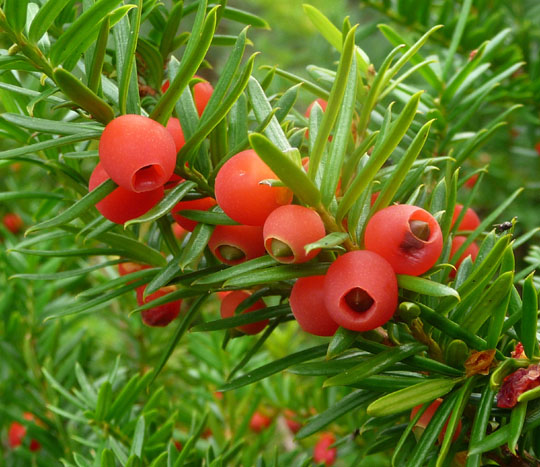Japanese Yews
Many kinds of yew bushes and trees are grown on the landscape, including Japanese yews, English yew bushes and crosses between the two. But as always when discussing plants, it’s best, to begin with, the taxonomy, to ensure that everyone knows the exact plant to which we’re referring. In the case of yew bushes, we must pay particular attention to the taxonomy of the Japanese yews.
When people use the common name, “Japanese yews,” much confusion can arise. All true yews belong to the genus, Taxus. That includes Taxus cuspidata, plants that bear the common name, “Japanese yews.” However, plants of an entirely different genus, namely, Podocarpus macrophylla, are also commonly referred to as “Japanese yews,” so be careful. This is just one more instance illustrating why we use scientific names of plants when precision is required.
Yew bushes often serve either as foundation plants around a house or in hedges. Varieties used in privacy hedges are often proportionately taller than they are wide (since you need the extra height for screening). By contrast, yews with a spreading habit are more suitable as foundation plants or in short, decorative hedges. Yew bushes are slow growers. This is not necessarily a drawback for shrubs used as foundation plants since a slow growth-rate means lower maintenance (i.e., less pruning). However, homeowners who plant hedges (especially hedges specifically for privacy) usually desire quick results. If you have your heart set on using yew bushes to form a hedge, buy mature plants; otherwise, the wait will be unbearable for you.
All yew bushes are needle-bearing evergreens. The foliage on most is soft, dense and is a dark green color on top, with a lighter underside. The needles are flat. Most yew bushes can be grown in zones 4-7 in a soil with a neutral pH; they are generally evergreen. Yew bushes produce red berries called “arils.”
Yew bushes can be grown in sun or shade. Their shade-tolerance gives landscape designers an important option in challenging areas. Another selling point is the ease with which overgrown yew bushes can be rejuvenated. Most mature evergreens do not respond well to severe pruning. Arborvitae and yew bushes are the exceptions.
Sizes and shapes vary widely between the different varieties of yew bushes. It is important to be aware of these differences. Yew bushes suitable as foundation plants or short, decorative hedges won’t necessarily be a good fit for privacy hedges, and vice versa. Let’s take a look, then, at some of the cultivars of yew bushes, what they look like and common uses for them. English yew bushes (Taxus baccata) and Japanese yews (Taxus cuspidata) are among the most popular, as are their hybrid crosses (Taxus × media), which include Hicks yews (or “Hick’s” yews) and Taunton yews.
Irish Yew Bushes, Japanese Yews, Hicks Yews, Taunton Yews
1 Spreading English yew bushes (Taxus baccata ‘Repandens’): spreading growth habit, 2′-4′ high by 12′-15′ wide, and used as foundation plants or in short, decorative hedges. My favorite is “Pringles” variety.
2 Irish Yews (Taxus baccata ‘Fastigiata’): columnar shape, 15′-30′ high by 4′-8′ wide, and used in privacy hedges; one of the English yew bushes.
3 “Emerald Spreader” Japanese yews (Taxus cuspidata ‘Monloo’): spreading growth habit, 30″ high by 8′-10′ wide, and used as foundation plants or in short, decorative hedges.
4 Hicks yews (Taxus × media ‘Hicksii’): columnar shape, 12′-20′ high by 6′-10′ wide, and used in privacy hedges.
5 Taunton yews (Taxus × media ‘Tauntonii’): spreading growth habit, 3′-4′ high by 3′-4′ wide, and used as foundation plants or in short, decorative hedges; resists winter-burn.
The oil derived from yew bushes, taxol, is used for treating breast and ovarian cancer. But don’t let that fool you: all parts of yew bushes are poisonous, except for the fleshy red berry. And since yew seeds are poisonous, and the seed matures within the berry, even the latter can be considered “off limits.” Keep small children away from yew bushes!
Yews and Christmas Decorating
Prince Albert is usually credited with introducing the Christmas tree that graces nearly every house and high street in December. In truth, they appeared 40 years earlier. Queen Charlotte, the wife of George III, had a yew tree hung with sweets and toys and illuminated with small wax candles for a party for local children at Windsor on Christmas Day in the year 1800.
I hope all of you have a Merry Christmas! Until next time…Happy Gardening!!

